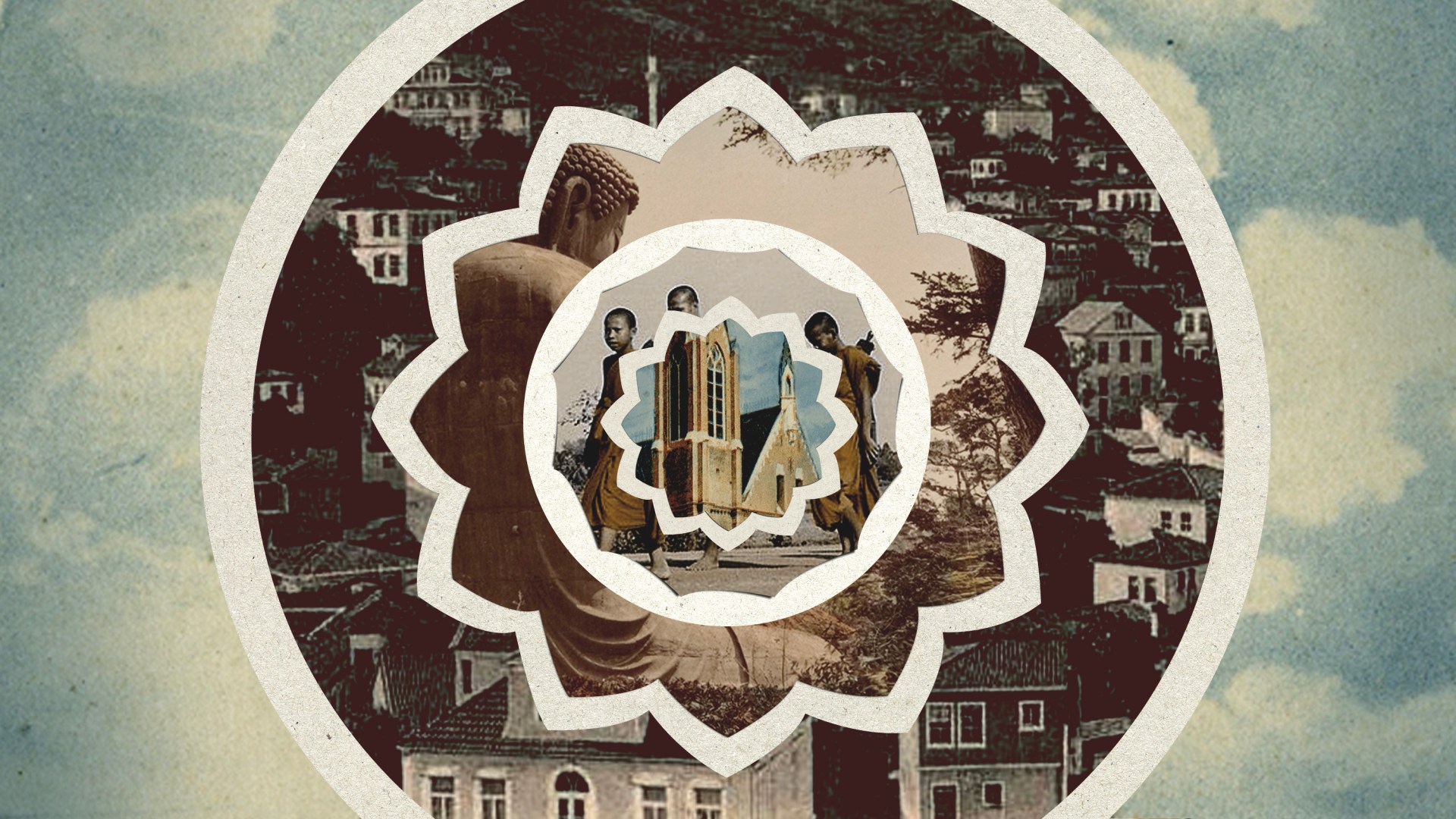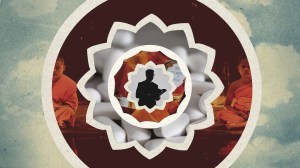In this series


This is the first article in the Engaging Buddhism series, which will explore different facets of Buddhism and how Christians can engage with and minister to Buddhists.
Churches dot Linwood, a predominantly Black neighborhood in Columbus, Ohio. Yet drive down a quiet road past Holy Spirit Church of Columbus and Christ Centered Apostolic Church and you’ll find an unexpected sight: a brightly colored Buddhist shrine with ornate gold accents and a pointed roof typical of Laotian architecture.
Twin red dragons guard the pathway to the shine, surrounded by reflections ponds. In the same compound is the Watlao Buddhamamakaram Buddhist temple, built in 2009 by Laotian immigrants. Inside, monks in saffron robes pray in front of golden statues of Buddha.
This Buddhist temple is a visible marker of the changing landscape of the United States. Since the 1965 Immigration and Nationality Act ended national origin quotas, the number of immigrants from Buddhist-background countries has grown drastically.
Today, Asians are the fastest-growing ethnic group in the United States, making up 7 percent of the US population, or 22 million people. Arriving to pursue higher education or job opportunities or to escape wars and turmoil, Asians will continue moving to the US, and demographers project the community will grow to 46 million by 2060.
This trajectory means US churches and Christians will more likely encounter neighbors who are Buddhist or from a Buddhist-influenced culture, as the religion significantly influences more than a billion people worldwide. Around 500 million people practice Buddhism, most of whom live on the Asian continent. China has the largest number of Buddhists (with about 245 million adherents), while seven countries have Buddhist majorities, most in Southeast Asia.
This provides ample opportunities for US churches to minister to Buddhists, yet most Christians are ill-prepared to reach out to them, said Sam George, director of the Global Diaspora Institute at the Wheaton College Billy Graham Center. A 2019 Pew study found that 58 percent of Americans said they knew nothing or not much about Buddhism, the second least understood religion behind Hinduism.
“We need to get every member of our church exposed and equipped to some level of knowledge and cross-cultural skills and comfortability to engage people from a Buddhist background,” said George.
To help the church better understand Buddhism, CT is launching Engaging Buddhism, a biweekly series that will look at different facets of the religion and how Christians can engage and minister to Buddhists. First, we will explore Buddhism’s spread through Asia to America’s shores, its influence in the US, and the opportunities churches have to reach the Buddhist diaspora.
‘Go now and wander’
Buddhist beliefs vary based on country and tradition, but all adhere to several fundamental doctrines: The religion centers on the teaching of Siddhartha Gautama, also known as the Buddha, who was enlightened to see the dharma or the truth. Buddhists don’t believe in a creator God but rather seek to end suffering in this life and the cycle of rebirths by following the Eightfold Path to reach nirvana (see sidebar for more on Buddhist beliefs). Humans are impermanent; instead, one’s karma—or tally of good and bad deeds—remains after death, dictating one’s place in the next life.
After Buddha’s death in 483 B.C., his teaching spread through his disciples, whom he called to “go now and wander for the welfare and happiness of many, out of compassion for the world. … Let not two of you proceed in the same direction. Proclaim the Dhamma that is … utterly perfect,” according to the Pali Canon, the Buddhist scripture.
The first Buddhists followed their teacher’s instructions and found a receptive audience. In caste-conscious India, Buddhism’s emphasis on the equality of all human beings attracted people in low castes and women. In the third century B.C., India emperor Ashoka converted to Buddhism and used state funds to send Buddhist missionaries to China and the rest of the world through the Silk Road.
When Buddhism entered different countries, the religion’s elasticity allowed it to integrate with local religions. Because it rarely challenged local norms, many could easily accept Buddhism alongside their existing faiths. This practice of syncretism led the religion to look quite different depending on the country. In China, Buddhism was mixed with Daoism and traditional ancestor worship. In Cambodia, its cosmology includes ghosts and spirits, ancestors and Brahma deities.
By combining with local religions, Buddhism created a strong bond with people’s nationalities. Often when trying to minister to Buddhists, Christians find that the greatest barrier to evangelism is the mindset that “to be Thai (or another nationality) is to be Buddhist.”
Appealing to the disillusioned
As Asians moved to the West, migration trends brought Buddhists into all regions of the United States. Americans’ first official introduction to Buddhism was at the 1893 Chicago World’s Fair, where the World’s Parliament of Religion invited Buddhists from Sri Lanka and Japan to explain their beliefs. Zen master Soyen Shaku argued that the idea of karma was compatible with modern science, while Buddhist reformer Anagarika Dharmapala spoke about the Buddha’s ideals of tolerance and gentleness.
Today the United States has around 1,000 Buddhist centers, and about 3 million Americans identify as Buddhists (although the number of those who practice some form of Buddhism is higher). Westerners who have “postmodern disillusionment with the church and Christianity” are easily drawn to Eastern mystical experience, George said. Today, Buddhist ideas have influenced American culture, from Star Wars to meditation retreats to mindfulness self-help books. Celebrities like Robert Downey Jr., Steve Jobs, and George Lucas have turned to Buddhism, while the Dalai Lama is quoted and revered.
“The materialistic world leaves us empty and wanting more,” George said. “Augustine said that we all have a God-shaped vacuum inside of us and we are trying to fill that with something.” When money and sex don’t fill that deeper need, some turn to the alternative provided by Buddhist evangelists.
Yet while Westerners view Buddhism as a philosophy, Paul De Neui, a former missionary to Thailand and professor of missiology at North Park Theological Seminary, noted that this concept isn’t embraced by Buddhists in the East, who see Buddhism as a cultural identity. This means they are Buddhists because their parents are Buddhist.
“That is not so appealing to the West,” De Neui said. Collectivist values “clash with a lot of the independent individualism that we have in this country.”
Instead, Americans often pick and choose aspects of Buddhism—such as meditation or veganism—that align with their worldviews, while rejecting ideas such as celibacy or abstaining from intoxicants.
Buddhists in the East don't see a problem with this “as long as nothing is spoken badly about Buddhism,” De Neui said, noting that the lack of orthodoxy is what makes the religion appealing. “Buddha not only approved that but mandated that: Go find it, go do it your own way.”
Opportunity in reaching the diaspora
At the same time, Christians have a unique opportunity to minister to the influx of the Buddhist diaspora in a way missionaries to Asia don’t have, George said.
“They are more open to the Christian gospel witness than in their home country,” said George. “Displacement causes longing and struggles—‘How do I see myself in light of being new people in this land?’ … That process deepens the longing for spirituality.”
Asian culture is also much more communal, so spiritual conversion in Asia often entails going against the family, the community, and even one’s nationality. But in the US, “now you are individually pursuing truth … so you don’t have to fight social and communal pressures you would face back in India” or other countries, George said.
For churches interested in engaging Buddhist neighbors, George proposes several practical steps:
1. Prepare spiritually: If this is something your church feels called to because of the Buddhists who live in the neighborhood, start by praying. Ask for a heart to care for Buddhists and for opportunities to reach out to them.
2. Do your homework: Read about the basics of Buddhist faith, but also seek to understand what Buddhism looks like in the country and culture your neighbors are from. Gather a core team of people in your church to do a study about Buddhism.
3. Visit Buddhist temples: Be curious and get to know the monks in your local area. It’s important to spiritually prepare yourself before you put yourself in an environment of that sort. Build relationships, get to know who they are, and be genuinely interested. Don't focus on just converting them or turning them into a project.
4. Love your Buddhist neighbors: As you get to know them, find ways to love and serve them. Earn the right to share your faith in Jesus Christ. They need to see something worthwhile in our faith: a genuine love for Jesus and love for others.
George noted that at times this can take months or years of relationship.
“There’s no quick fix, no magic wand,” he said. “There are many genuine followers of Buddha. … So they’re not very attracted unless your Jesus is more compelling. We need to make Jesus look real and relevant and attractive to those who have come from a very high spirituality of Buddhism in Asia.”
Next time in the Engaging Buddhism series, we will take a look at karma: what it means, what it doesn’t mean, and how Christians can engage with its implications.






















